 |
 |
|
 |
 |
Hibernicons: A Virtual Trip to Ireland
Come Irishmen, to the Hibernicon come, And see the loved scenes
of our Green Island Home. These scenes that will steal O'er your heart with delight, As we wander again through dear Erin tonight, See her temples, her towers, and castles that stand. In ruins magnificent, throughout the land, As monuments, glorious, of days that are gone,
When Erin in freedom and chivalry shone. Excerpt from
a broadside for MAC EVOY'S Pictoral, Musical & National Entertainment.
The John Mac Evoy Family
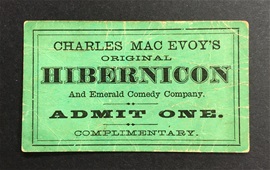 This is a complimentary ticket to Charles MacEvoy's Original Hibernicon, 1870, from the collection of Sue Truman.
This is a complimentary ticket to Charles MacEvoy's Original Hibernicon, 1870, from the collection of Sue Truman.
The Hibernicon shows began in Chicago with the John Mac Evoy family in the early 1860s. His Mirror of Ireland show had the
standard set up: the moving panorama with accompanying narration and piano music. A few years later he added Irish instrumentation (e.g. Uilleann piping, fiddle and harp), Irish stepdancing, comedy skits and song to provide more of an Irish variety show. This
new formula proved to be a great success. Before long, there were others producing similar shows, some even using the Mac Evoy name. John's
son Charles started his own Hibernicon company in the 1870s. He inserted "Original" into the company name, Charles Mac Evoy's Original Hibernicon, to set them apart from others (see admission ticket).
Michelle Granshaw spent a decade researching the shows. She named them "Hibernicons" after
the name that the Mac Evoys used. For a much "deeper dive" you can read her 381 page dissertation published in 2012 The Hibernicon and Visions of Returning Home: Popular Entertainment in Irish America from the Civil War to World War I
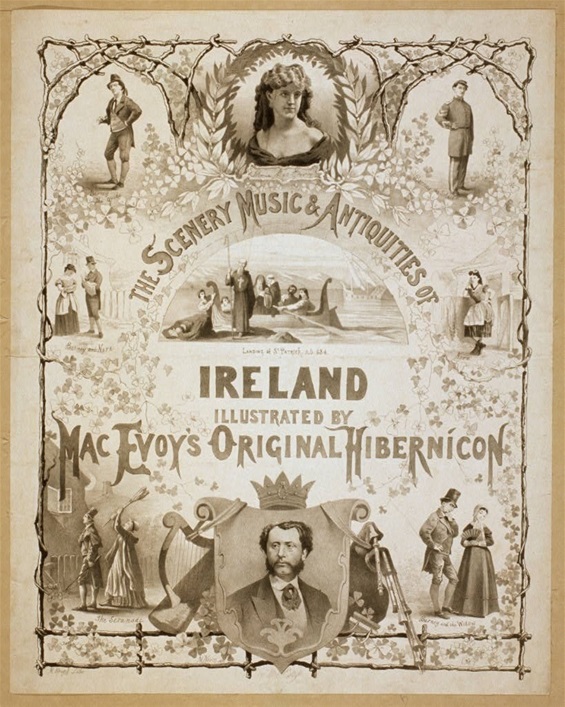 Charleston, SC Hibernian Hall March 21-26?, 1870 "MacEvoy's Great Pictorial, Musical, and National Entertainment, "The Hibernicon! "Representing a Tour in Ireland... "The Great Jerry Cohan as Barney the Guide. "Marie D. MacEvoy as Norah. "Miss Kate Halpine as Mrs. O'Callahan and the Wodow.
"Charles MacEvoy, Musical Director and Lecturer. Image from the Library of Congress.
Charleston, SC Hibernian Hall March 21-26?, 1870 "MacEvoy's Great Pictorial, Musical, and National Entertainment, "The Hibernicon! "Representing a Tour in Ireland... "The Great Jerry Cohan as Barney the Guide. "Marie D. MacEvoy as Norah. "Miss Kate Halpine as Mrs. O'Callahan and the Wodow.
"Charles MacEvoy, Musical Director and Lecturer. Image from the Library of Congress.
A Description from One Who Witnessed Them
HIBERNICONS originated in America and were performed from Civil War times up to World War I. Their most popular time was during the 1870s.
The following description comes from an unknown writer who reminisces about seeing the Hibernicon shows.
The
panorama itself used to be set up on the stage a short distance from the back drop (that is, near the back wall of the stage). The panoramas consisted of a series of paintings about
five by eight feet. They were attached to two upright spools and the operator usually was a boy who sat out of sight beside one spool and wound it up as the other spool unwound. There was a curtain in front with an opening just large enough to make a frame
for the picture. Among the most popular of these panoramas were those with a special appeal to the Irish people of whom there were many immigrants in those days. In connection with the
showing of the panorama and its accompanying lecture, a number of specialty performers took part. The lecturer usually played the part of the head of a small party of tourists taking in the beauties of the Emerald Isle. There would be an Irish comedian active
as a guide who would break into a song or a dance at the slighest provocation.' This description appeared in the Plattsburgh, N.Y. Daily Press in 1939. From the website WhitmerPipes.com
The Story Line
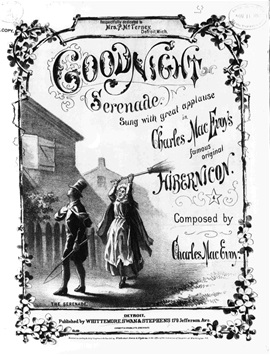 Barney is wooing Nora. Little does he know, Nora's mother has excellent hearing. Sheet music by Charles Mac Evoy, 1871. From the Library of Congress.
Barney is wooing Nora. Little does he know, Nora's mother has excellent hearing. Sheet music by Charles Mac Evoy, 1871. From the Library of Congress.
The Hibernicon shows did have a story line of sorts. A group of tourists leave New York Harbor on a steamship, headed for Ireland. The group visits popular attractions such
as St. Patrick's Cathedral and Blarney Castle as well as Ireland's beautiful lakes, waterfalls and countryside. Then they board the steamer and return to America. Along the
way, the tour guide Barney meets Nora and falls in love. This creates opportunities for song and for comedy. Will Nora give Barney the boot? Will Nora's mother give Barney a hit over the head?
Hibernicon Moving Panorama Scrolls
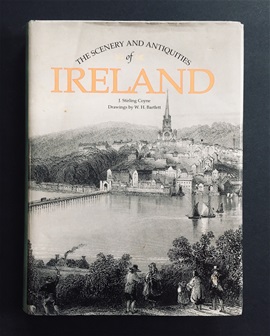 The Scenery and Antiquities of Ireland, published in 1842, contained engravings on steel of iconic places in Ireland along with descriptions, historical information and poems. Sue Truman collection.
The Scenery and Antiquities of Ireland, published in 1842, contained engravings on steel of iconic places in Ireland along with descriptions, historical information and poems. Sue Truman collection.
Unfortunately, none of the Hibernicon moving panorama paintings survived. We can get a glimpse of what they might have looked like from programs, newspaper ads, sheet music, souvenirs, broadsides, songsters
and travel books!
Michelle Granshaw writes that at least one company, McGill & Strong's Mirror of Ireland, used engravings from the travel book The Scenery
and Antiquities of Ireland by J. Sitrling Coyne and W. H. Bartlett as source material for their painting. The illustration in the souvenir postcard below was taken from an engraving from the book.
Other artists claimed to paint from sketches made at the scene.
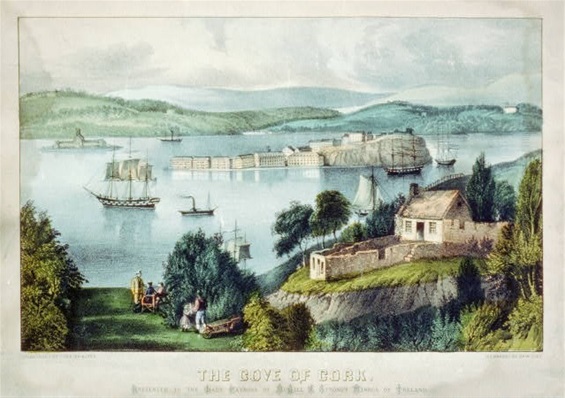 The Cove of Cork. This gorgeous souvenir card was presented to the lady patrons of McGill & Strong's Mirror of Ireland. Currier & Ives, hand-colored lithograph, Library of Congress. This image was adapted from the "Cove of Cork" engraving in the travel book The Scenery and Antiquities of Ireland. Michelle Granshaw writes about this in her 2012 dissertation.
The Cove of Cork. This gorgeous souvenir card was presented to the lady patrons of McGill & Strong's Mirror of Ireland. Currier & Ives, hand-colored lithograph, Library of Congress. This image was adapted from the "Cove of Cork" engraving in the travel book The Scenery and Antiquities of Ireland. Michelle Granshaw writes about this in her 2012 dissertation.
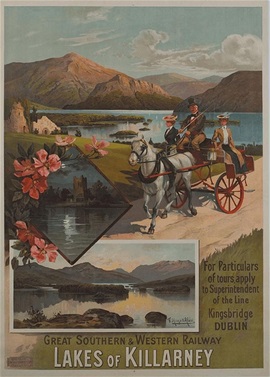 This travel poster was painted by French painter Hugo d'Alesi (1849-1906). Coincidentally, he went on to paint the epic Mareorama moving panorama which was shown at the 1900 Paris Exposition.
This travel poster was painted by French painter Hugo d'Alesi (1849-1906). Coincidentally, he went on to paint the epic Mareorama moving panorama which was shown at the 1900 Paris Exposition.
This beautiful travel poster was painted by French painter, Hugo d'Alesi who was known as the "Father of the Travel Poster." It shows a couple out for a drive in a Jaunting car by the Lakes of Killarney, a popular scene in Hibernicon moving panoramas. Could travel posters also have been an inspiration for moving panorama artists?
McGill's Mirror of Ireland - Scenes from the Program
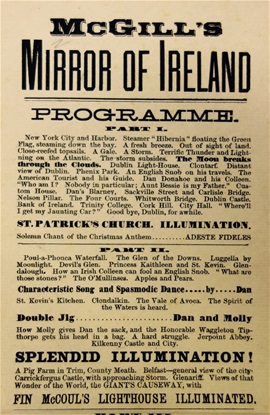 This is a section of the program from McGill's Mirror of Ireland, 1870s.
This is a section of the program from McGill's Mirror of Ireland, 1870s.
Hibernicon programs, like this one from McGill's Mirror of Ireland, gives us detail of the moving panorama scenes, songs, stepdancing and lighting effects.
Part 1.
New York
City and Harbor. Steamer "Hibernia" floating the Green Flag, steaming down the bay.
A Gale. A Storm.
Terrific Thunder and Lightning on the Atlantic. The very popular "storm at sea" scene. It was a great crowd pleaser with lighting effects. In addition, sound effects were commonly used such as a hand-cranked
wind machine, thunder sheet or rain box. The storm subsides. The Moon breaks through the Clouds. Moonlight scenes were also popular. The moon shape in the scroll may have been made of a lighter
colored material or more transparent material which could be illuminated from behind by means of a candle or limelight.
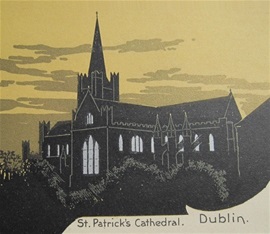 The St. Patrick's Cathedral scene may have looked like this when illuminated.
The St. Patrick's Cathedral scene may have looked like this when illuminated.
Part 1 (continued) ST. PATRICK'S CHURCH - ILLUMINATION
This scene might have shown the church as more of a dark silhouette image. The windows would be white or a lighter color so when lit from behind, it would look like light shining through stain glass windows.
Part 2 SPLENDID ILLUMINATION! The word ILLUMINATION is mentioned three times in CAPS in Part 1 and 2 of the program. My guess is in the St. Patrick's Cathedral and the Finn McCoul's Lighthouse scene, this refers to lighting effects to the scroll, illuminating the
cathedral windows or making the lighthouse lense light up.
In the section towards the bottom where it lists SPLENDID ILLUMINATION of a Pig Farm in Trim, the city
of Belfast and The Giant's Causeway, this might refer to magic lantern slides.
Double Jig....Dan and Molly A double jig is a particular kind of tune with accompanying steps. This looks like a step dance duet.
Harrigan's Double Hiberian Company - Advertising Strategies
 Harrigan's Hiberian Tourist's Songster, published 1885, 32 pages. A picture of the jaunting car on the cover.
Harrigan's Hiberian Tourist's Songster, published 1885, 32 pages. A picture of the jaunting car on the cover.
Harrigan's Double Hiberian Co. was popular in the 1880s. They held elaborate parades to advertise their shows. This proved to be successful as written in about the Watertown (NY) Times
newspaper, April 1, 1886.
Harrigan's Tourists arrived in the city yesterday morning, and were soon arranging their trappings, ponies, jaunting
car, musicians, pipers, etc., for a street parade. At 12'oclock everything was in readiness, the lightning drum major gave the order, "Forward march," the band struck up, the pipers played, flags were thrown to the breeze, a small boy screamed with delight
and the entire troupe, seventeen in number, commenced their tour of the city. Up to this time, there had only been a moderate sale of seats, many believing the entertainment was similar to the old-time panorama, but when the troupe's strength became known,
the sale increased and last night the opera house was crowded...
The last sentence above is telling, the popularity
of the shows was waning by the 1880s, but Harrigan's was still drawing a crowd. The use of the parades helped but they also had some of the most talented dancers and musicians of the day as mentioned below.
Harrigan's with Uilleann Piper Patsy Touhey
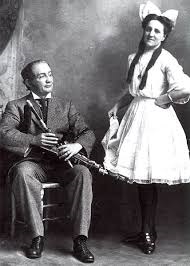 Patrick (Patsy) and Mary Touhey who was a stepdancer.
Patrick (Patsy) and Mary Touhey who was a stepdancer.
Harrigan's had the young Patsy Touhey (1865-1923) playing in the company during the 1885/86 season. He was to become one of the greatest Uilleann pipers of that time and is still an inspiration today.
This was his first theatrical performing experience. He went on to perform in plays and musicals such as The Ivy Leaf. At the Chicago World's Fair he performed in one of the "Irish Villages."
For
more information about Patsy Touhey's playing with Harrigan's Hiberian Co., visit the website of piper and pipe-maker Nick Whitmer Patsy Touhey's Earliest Known Tour.
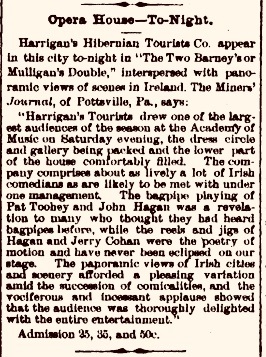 Ogdensburg, NY, Advance & Democratic, October 28th, 1886.
Ogdensburg, NY, Advance & Democratic, October 28th, 1886.
Not only did Harrigan's Hiberian Co. have Patsy Touhey playing the pipes, they also had Jerry Cohan (father of George M. Cohan "Give My Regards to Broadway" fame) as the Barney "tour guide". Cohan was a master showman
and stepdancer and performed with shows in the 1860s and 70s including Mac Evoy's. To see and hear Patsy Touhey playing for the stepdancing of Jerry Cohan must have been electric.
The
bagpipe playing of Pat Toohey and John Hagan was a revelation to many who have thought they have heard the bagpipes before, while the reels and jigs of Jerry Cohan were the poetry of motion and have never been eclipsed on our stage.
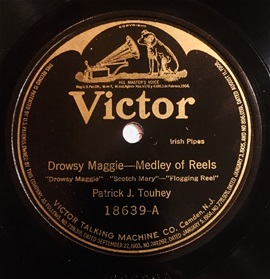 The Drowsy Maggie set, from the collection of Richard Twomey.
The Drowsy Maggie set, from the collection of Richard Twomey.
Although we will not get to see one of the 19th century Hibernicon moving panoramas (unless one
is rediscovered in an attic or museum) we can hear a bit of the music. There exists a few recordings of singers and musicians who played in the shows. In 1919, towards the end of his life, Patsy Touhey recorded a three 78s. I have used
one of those recordings in the crankie below. Enjoy!
I created this crankie as a tribute to Hibernicons and piper Patsy Touhey who plays three reels on this 78: Drowsy Maggie, Scotch Mary and The Flogging. The crankie scroll contains machine cut and hand cut Tyvek images and torn tissue paper glued to a white Tyvek scroll. Thank you to Richard Twomey for use of the 78 recording and Michael Twomey for filming. Nov. 2017.
Hibernicons in America and Beyond
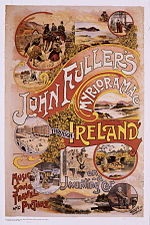 John Fuller's Myriorama Through Ireland was popluar in Australia. This show featured magic lantern slides instead of a moving panorama which in 1898 were considered to be more modern than the moving panorama. Find out more at RelativesMatter.com
John Fuller's Myriorama Through Ireland was popluar in Australia. This show featured magic lantern slides instead of a moving panorama which in 1898 were considered to be more modern than the moving panorama. Find out more at RelativesMatter.com
There were many more Hibernicon Companies than those mentioned on this page. Nick Whitmer's website lists at least 40 different companies. Some toured up into Canada and over to Ireland, England, Australia and New Zealand. Popularity of the shows spread abroad resulting in companies originating
in Ireland and Australia.
Granshaw, Michelle, "Irish on the Move, Performing Mobility in American Variety Theatre", University of Iowa Press, Iowa City, 2019. Favorite passage - a reminiscence from a 19th century spectator: My first theatrical entertainment - witnessed when I was a good deal less than knee-high was Jerry and Helen Cohan...in Haworth's Hibernica - a program that consisted
largely of the Cohans and a panorama background on hand-cranked rollers. A few seconds earnest twisting of the crank brought about a miraculously quick change of scene from the Giant's Causeway to the streets of Dublin to Lakes of Killarney and so forth
through the whole gamut of Irish scenery - and the Cohans did something gloriously exciting in front of each scene: a song and dance, or a jig, or a reel, or a sentimental ballad perhaps...and their show was out and away the most magnificent thing I'd ever
seen.
|
|
 |
|
|
|